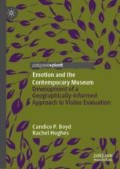Abstract
This chapter provides the first of two case studies of creative/arts-based research within a museum context. Boyd and Hughes describe and explain a research project that used a drawing method to better understand first-time visitor experiences of Rome’s Museo Laboratorio della Mente (Museum of the Mind). Their analysis of more than sixty drawings produced across two workshops garners insights about the museum’s novel and technologically-sophisticated exhibits as well as reflections on the drawing method itself.
Access this chapter
Tax calculation will be finalised at checkout
Purchases are for personal use only
References
Anderson, B., & Harrison, P. (2010). The promise of non-representational theories. In B. Anderson & P. Harrison (Eds.), Taking-place: Non-representational theories and human geography. Farnham, UK: Ashgate.
Brice, S. (2018). Situating skill: Contemporary observational drawing as a spatial method in geographical research. cultural geographies, 25, 135–158.
Causey, A. (2017). Drawn to see: Drawing as an ethnographic method. Toronto, Canada: University of Toronto Press.
Causey, C., & Causey, A. (2012). Drawing flies: Artwork in the field. Critical Arts, 26, 162–174.
Cirifino, F., Giardina Papa, E., & Rosa, P. (2011). Studio Azzuro: Musei di Narrazione (Museums as narration). Milan, Italy: Silvana Editoriale Spa.
Coleborne, C. (2001). Exhibiting ‘madness’: Material culture and the asylum. Health & History, 3, 104–117.
Coleborne, C. (2003). Remembering psychiatry’s past: The psychiatric collection and its display at Porirua Hospital Museum, New Zealand. Journal of Material Culture, 8, 97–118.
Ellis, J., Hetherington, R., Lovell, M., McConaghy, J., & Viczko, M. (2013). Draw me a picture, tell me a story: Evoking memory and supporting analysis through pre-interview drawing activities. Alberta Journal of Educational Research, 58, 488–508.
Hawkins, H. (2011). Dialogues and doings: Sketching the relationships between geography and art. Geography Compass, 5, 464–478.
Hawkins, H. (2015). Creative geographic methods: Knowing, representing, intervening. On composing place and page. cultural geographies, 22, 247–268.
Literat, I. (2013). ‘A pencil for your thoughts’: Participatory drawing as a visual research method with children and youth. International Journal of Qualitative Methods, 12, 84–98.
Martelli, P., & Cottino, G. (2006). The age of anxiety: Stones, feathers and re-institutionalization. Anthropology & Medicine, 13, 265–271.
Massumi, B. (2002). Parables for the virtual: Movement, affect, sensation. Durham, NH: Duke University Press.
MLM. (n.d.). Museo Laboratorio della Mente. Webpage. Available at http://www.museodellamente.it/.
Mulcahy, D. (2016). ‘Sticky’ learning: Assembling bodies, objects and affects at the museum and beyond. In J. Coffey, S. Budgeon, & H. Cahill (Eds.), Learning bodies. Singapore: Springer.
Reason, M. (2010). Watching dance, drawing the experience and visual knowledge. Forum for Modern Language Studies, 46, 1–24.
Swords, J., & Jeffries, M. (2015). Tracing postrepresentational visions of the city: Representing the unrepresentable Skateworlds of Tyneside. Environment and Planning A: Economy and Space, 47, 1313–1331.
Taussig, M. (2011). I swear I saw this: Drawings in fieldwork notebooks, namely my own. Chicago and London: University of Chicago Press.
Acknowledgements
The authors acknowledge their anonymous participants and collaborators Pompeo Martelli (Museo Laboratorio della Mente ASL Roma 1), Sarah Bennett (Kingston University), Hester Parr (University of Glasgow), and Claudia Demichelis.
Author information
Authors and Affiliations
Corresponding author
Rights and permissions
Copyright information
© 2020 The Author(s)
About this chapter
Cite this chapter
Boyd, C.P., Hughes, R. (2020). The Museo Laboratorio della Mente. In: Emotion and the Contemporary Museum. Palgrave Pivot, Singapore. https://doi.org/10.1007/978-981-13-8883-5_3
Download citation
DOI: https://doi.org/10.1007/978-981-13-8883-5_3
Published:
Publisher Name: Palgrave Pivot, Singapore
Print ISBN: 978-981-13-8882-8
Online ISBN: 978-981-13-8883-5
eBook Packages: Earth and Environmental ScienceEarth and Environmental Science (R0)

